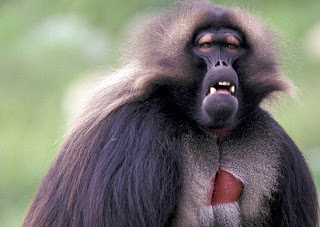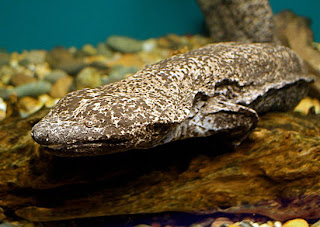Tired of seeing run-of-the-mill lions, tigers, and bears? Then say "oh my!" to these oddball creatures at zoos and sanctuaries worldwide—from a giant Chinese salamander to a little lemur called the aye-aye.
By JD Rinne, Thursday, August 6, 2009 Subscribe to the magazine
Aye-aye
Weirdness factor: Where to start? The aye-aye is a kind of lemur, with large round ears that rotate independently. How does it eat? There are no woodpeckers in Madagascar, but the aye-aye has evolved to feed like one, using its long middle finger to scoop out grubs in tree bark.
See it in: Madagascar (and the Bristol Zoo Gardens).

The aye-aye is a kind of lemur, with large round ears that rotate independently. The aye-aye feeds using its long middle finger to scoop out grubs in tree bark. See it in Madagascar (and the Bristol Zoo Gardens). (Courtesy Bristol Zoo Gardens)
Proboscis Monkey
Weirdness factor: The male proboscis monkey has a pendulous nose that is thought to amplify his calls to females (and his warnings to big-nosed rivals). The most dominant male usually has the biggest nose and can collect a harem of five to eight females.
See it in: Borneo (and the Singapore Zoo).

The male proboscis monkey has a pendulous nose that is thought to amplify his calls to females (and his warnings to big-nosed rivals). See it in Borneo (and the Singapore Zoo). (Gavriel Jecan/Corbis)
Naked Mole Rat
Weirdness factor: Almost totally blind, the naked mole rat is one of only two species of mammals that live in colonies with a caste system, like termites or ants. There's one queen and sometimes hundreds of workers and soldiers—which are expected to sacrifice themselves in battle should a snake appear (and not lose its appetite).
See it in: Ethiopia, Kenya, and Somalia (and Zoo Atlanta and the National Zoo).

Almost totally blind, the naked mole rat is one of only two species of mammals that live in colonies with a caste system, like termites or ants. See it in Ethiopia, Kenya, and Somalia (and Zoo Atlanta and the National Zoo). (Courtesy Jessie Cohen/Smithsonian's National Zoological Park)
Philippine Tarsier
Weirdness factor: The tiny tarsier's eyes are about twice the size of a human's and have no peripheral vision. Tarsiers pounce on prey with their vulnerable eyes shut tight, for protection (because who wants a cricket stuck in their eye?).
See it in: The southern Philippine islands of Bohol, Samar, Leyte, and Mindanao (and the Philippine Tarsier and Wildlife Sanctuary in Bohol).

The tiny Philippine tarsier's eyes are about twice the size of a human's and have no peripheral vision. See it in The southern Philippine islands of Bohol, Samar, Leyte, and Mindanao (and the Philippine Tarsier and Wildlife Sanctuary in Bohol). (Frank Lukasseck/Corbis)
Emperor Tamarin
Weirdness factor: Named for the last emperor of Germany, this tamarin's wildly eccentric moustache (strikingly similar to Mr. Monopoly's) is something of a mystery. Experts think it might be a unique identifier, as a fingerprint is for humans.
See it in: Bolivia, Brazil, and Peru (and the Paignton Zoo, in Devon, England).

The emperor tamarin's wildly eccentric moustache (strikingly similar to Mr. Monopoly's) is something of a mystery. Experts think it might be a unique identifier, as a fingerprint is for humans. See it in Bolivia, Brazil, and Peru (and the Paignton Zoo, in Devon, England). (Courtesy Paignton Zoo)
Matamata Turtle
Weirdness factor: The knobby, gnarled matamata uses its huge mouth to suck in unsuspecting food sources as they pass by. In Spanish, matamata means "it kills, it kills."
See it in: The Amazon River in Brazil, and in parts of Trinidad and Guyana (and the Honolulu Zoo and San Diego Zoo).

The knobby, gnarled matamata turtle uses its huge mouth to suck in unsuspecting food sources as they pass by. See it in The Amazon River in Brazil, and in parts of Trinidad and Guyana (and the Honolulu Zoo and San Diego Zoo). (Courtesy San Diego Zoo)
Gelada Baboon
Weirdness factor: This primate's fangy yawn is actually a display of aggression to show off its canine teeth. The red patch of skin on the female's chest gets brighter as her hormone levels increase. As a natural design feature, it's probably a little too much information.
See it in: Eritrea and Ethiopia (and the Bronx Zoo).

The red patch of skin on the female gelada baboon's chest gets brighter as her hormone levels increase. As a natural design feature, it's a little too much information. See it in Eritrea and Ethiopia (and the Bronx Zoo). (Courtesy Bronx Zoo/WCS)
Chinese Giant Salamander
Weirdness factor: The largest salamanders in the world, these unattractive guys can grow to three feet long. But that doesn't stop them from being eaten: Their meat is considered a delicacy in parts of China.
See it in: The streams and lakes of central China and Taiwan (and the Steinhart Aquarium in San Francisco).

The unattraChina. See it in The streams and lakes of central China and Taiwan (and the Steinhart Aquarium in San Francisco). (Courtesy Steinhart Aquarium)ctive Chinese giant salamander can grow to three feet long. Their meat is considered a delicacy in parts of
Echidna
Weirdness factor: The echidna is an evolutionary mashup—it has a pouch for its young like a kangaroo, spines like a porcupine, and a sticky tongue like an anteater. Oh, and it lays eggs like a chicken.
See it in: Tasmania, Australia, and New Guinea (and the Cleveland Metroparks Zoo, which has a short-beaked echidna).

The echidna is an evolutionary mashup—it has a pouch for its young like a kangaroo, spines like a porcupine, and a sticky tongue like an anteater. Oh, and it lays eggs like a chicken. See it in Tasmania and New Guinea (and the Cleveland Metroparks Zoo). (Courtesy Cleveland Metroparks Zoo)
Victoria Crowned Pigeon
Weirdness factor: These blue, turkey-size pigeons with outrageous plumage live mostly on the ground, mating for life and building sturdy nests for their young.
See it in: New Guinea (and the Philadelphia Zoo).

The blue, turkey-size Victoria crowned pigeon has outrageous plumage and lives mostly on the ground, mating for life and building sturdy nests for their young. See it in New Guinea (and the Philadelphia Zoo). (Courtesy Philadelphia Zoo)
White-faced Saki Monkey
Weirdness factor: Often called flying monkeys, white-faced sakis rarely let their feet hit the ground. They prefer to stay in the mid-level trees of the rain forest, where they can jump up to 30 feet in a single bound and can run upright along narrow branches.
See it in: The rain forests of northeastern Brazil, French Guiana, Guyana, Suriname, and Venezuela (and the Elmwood Park Zoo in Norristown, Pa.).

White-faced sakis prefer to stay in the mid-level trees of the rain forest, where they can jump up to 30 feet in a single bound. See it in Northeastern Brazil, French Guiana, Guyana, Suriname, and Venezuela (and the Elmwood Park Zoo in Norristown, Pa.). (Courtesy Elmwood Park Zoo)
Tree Pangolin
Weirdness factor: This insect eater's scales feel a little like human fingernails. But don't touch: Like the common skunk, the pangolin has an unpleasant-smelling spray for those who get too close.
See it in: Central Africa's rain forests (and the San Diego Zoo—which displays the tree pangolin infrequently, and without a lot of advance notice).

The tree pangolin is an insect eater with scales that feel a little like human fingernails. But don't touch: Like the common skunk, the pangolin has an unpleasant-smelling spray for those who get too close. See it in Central Africa's rain forests (and the San Diego Zoo). (Courtesy San Diego Zoo)
Pygmy Marmoset
Weirdness factor: Pygmy marmosets are the smallest monkeys in the world. They communicate though whistles and twitters, but when hostile they emit a frightening cry that's audible to peers but inaudible to humans.
See it in: Brazil, Colombia, Ecuador, and Peru (and the Houston Zoo and the Philadelphia Zoo).

Pygmy marmosets communicate though whistles and twitters, but when hostile they emit a frightening cry that's audible to peers but inaudible to humans. See it in Brazil, Colombia, Ecuador, and Peru (and the Houston Zoo). (Courtesy Houston Zoo)
Leafy Sea Dragon
Weirdness factor: Male leafy sea dragons carry and give birth to the offspring. Instead of swimming upright, like sea horses, the leafy sea dragon swims in a horizontal position. It uses its tube-shaped mouth as a straw to suck up food.
See it in: The waters of the southeastern Indian Ocean, near southern and western Australia (and the Georgia Aquarium in Atlanta).

Instead of swimming upright, like sea horses, the leafy sea dragon swims in a horizontal position and uses its mouth as a straw to suck up food. See it in The southeastern Indian Ocean, near southern and western Australia (and the Georgia Aquarium in Atlanta). (Courtesy Georgia Aquarium)
Note: This story was accurate when it was published. Please be sure to confirm all rates and details directly with the companies in question before planning your trip.
You may also want to visit my web site, particularly on the subject of travel @ http://www.arcearch.com/
ReplyDelete